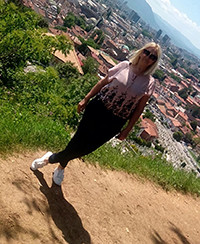
Baščaršija is a famous tourist destination and is located in the heart of Sarajevo. It was built around year 1460 by Isa-beg Isakovic. The name Baščaršija originates from the Turkish words " baš" meaning "main" and "čaršija" meaning "square, market". At that time, Baščaršija became a shopping center with 12,000 stores and its importance was evidenced by the presence of Venetian, Dubrovnik and Florentine colonies.
On the square, around the stores, there was a "sebilj" (a public fountain) where travelers, merchants and porters looking for work used to gather. Nowadays only "pigeons from Sarajevo" gather around the fountain, and there are numerous bars next to the fountain where visitors can have a cup of coffee with a “rahatlokum” (a Bosnian sweet) in antique copper utensils. The first “sebilj” was built in 1754 by Mehmed Pasha Kukavica but that fountain was burned down in a fire. The Austro-Hungarian monarchy hired architect Josip Vrancaš and, according to his project, built a new fountain in 1891. The fountain was restored before the Winter Olympic Games held in Sarajevo in 1984. Nowadays, you can find replicas of "Sarajevo's sebilj" in Belgrade, in Turkish Rize and in American St. Louis.
The appearance of Baščaršija was significantly improved by Gaza Huserev-bey when in 1521 he built numerous landmarks in this place, such as Bey's mosque, the Clock Tower, a madrasah, a library, a hanikah (a tekke with a boarding school for studying the Qur'an), hamas (baths) and a bezistan.
Here visitors may also find an Old Orthodox church and it is interesting that at the same time you can hear the sound of ezana and the sound of a church bell. This is possible only in Sarajevo.
The cobblestone streets were named after the following occupations: ashiluk (catering), saraci (saddlers), tabaci (tanneries), silversmith (gold and silver).
It really doesn't matter whether you are hungry or not because the irresistible smell of food and spices provokes and invites you to try “chopped burek” and if you don’t like the barbecue in well-known auspices you can eat: duck, Bey soup, sogan- dolma, sarma and many other Balkan specialties.
Tourists also enjoy “Sweet Corner" (an intersection between two candy stores) where they can taste delicious baklava, baklava with dried plums, kadif and indispensable Sarajevo’s boza.
Interesting facts:
In the vicinity of Baščaršija's fountain, even carrier Samuel was waiting for a job (a character from the novel “Carrier Samuel” by the famous writer Isaac Samokovlija from Bosnia and Herzegovina).
Author of the text

Sabina Burić - our correspondent for the city of Sarajevo
Contact: [email protected]
photo credit: Aldin Hrvačić - instagram profil